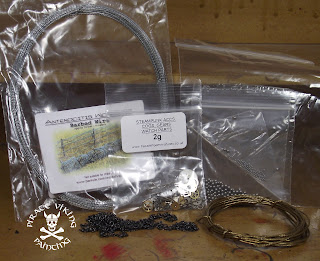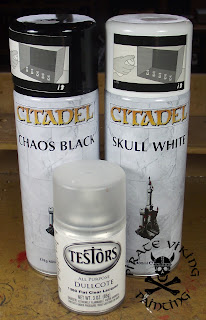And so at last we reach the end of our hard hat odyssey with the third and final part of Tooltime, today, it's all about finishing touches.
For me there are three elements to finishing off a model, transfers (decals), weathering and basing.
These two are the two big guns in my arsenal when it comes to transfers. Rather than go over their utility here I shall point you to the tutorial that I did a while ago and move along!
Once you have your transfers in place you can start with the weathering (if the model needs it). Most of the weathering that I do is performed with a brush and regular paint (see here for a tutorial) but just recently I had a few new toys turn up.
The first toy is this collection of weathering powders. I chose the Forgeworld ones because, bizarrely, they are some of the cheapest on the market. Now I am not going to pretend to be an expert on these as I have only just started using them. From what I have seen so far, you need to use them sparingly, be very, very careful about getting water on them as it turns them into paint and mix them together for transitions as they don't blend terribly well. Below are two examples of where I have used them recently.
I used a light dusting of Light Earth to enhance the tarmac texture of the road and Aged Rust on the manhole cover on the Hellboy figure. The Sorcerers cloak was an attempt at blending multiple earth shades to get a convincing dirt texture. Both look fairly nice!
The next new toy is a set of enamel weathering products and a pot of odorless turpentine. These enamel paints are handy for us because they can be feathered out with the turpentine without affecting the acrylic coat below. As a result you can get some very interesting effects. Check out the AK Interactive blog for some expert examples of what you can do with this stuff. The only model I have used these on so far is the sorcerer again:
I splodged generous amounts of Slimy Grime Dark onto the green parts (over a coat of Catachan Green) and then feathered it out with the turpentine to provide a nice realistic slimey film over the whole piece. Really looking forward to playing with some of the others!
Finally we come to basing! Take a look at the array of products in the picture above. This is just part of my basing collection. Seriously folks you can't skimp on this stuff, it makes the difference between a good model and a great one. Here's a rundown of what you can see in the picture above:
Texture:
- Modelling sand: my basic "soil" looking tool. Pretty much every model I ever paint has some of this on it! Just glue it down with PVA then when dry wash it with a coat of PVA watered down to the consistency of milk. Once dry, you really have to go it some to dislodge it!
- Cork boulders: Tiny broken up pieces of cork, a nice analogue for larger stones that aren't slate! Living in Wales I can get hold of slate by just wandering out of my front door but these little cork bits look wonderful. Treat the same way as Modelling Sand.
- Static Grass: There are two examples of Static Grass in the photo, the baggie in the front is full of normal GW Scorched Grass, the tub at the far right is full of my own mix "Wasted Grass" which is a blend of a few Antenociti's Workshop grass colours to give a more realistic finish. Check out the difference below:
 |
| "Wasted Grass" |
 |
| "Scorched Grass" |
- Scatter: This is an older form of basing texture only one step up from the old dyed sawdust approach. There isn't much in the way of grassiness but I find it very useful for the smaller Flames of War figures. See below for an example:
- Grass Tufts: These are a fairly new idea in gaming. They are essentially pre-glued little tussocks of static grass. I do not believe that they should be used on their own. Instead they should enhance a base that already has static grass on it by adding texture. Below is an example:
Shrubbery:
- Coarse Turf: Essentialy a matrix of fine threads with scatter material glued to it that makes ace little bushes or, in larger pieces, whole hedgerows! You can see a piece of this material in the picture above.
- Weed tufts and Ivy: Just like Coarse turf and Grass Tufts these are pre-glued textures that simulate realistic foliage. I've used them most on my Warmachine figures so far:
- Leaf litter: These are seed pods that look uncannily like 28mm scale fallen leaves! Antenociti do a lovely range of them. I can recommend the "Mixed" and "Litter" pots. Mixed allows you to simulate fresh fallen leaves or trailing plants up buildings as they still have some green colouration. Litter is what is used in the picture above to simulate autumn fall of leaves. Make sure to wash them in watered down PVA to make them stick as they are light and delicate!
There are other tools you can use for basing though, in the picture above are: a big bag of clump foliage for hedges and explosions (more later), some plasticard strip that should really have been in part 1 and some dried roots lifted from my garden as fallen logs. Make sure you pick ones with texture and movement, a stick will always look like a stick. A twisty stick will look like a tree! The following picture gives an example.
I have also painted the log, don't leave it in it's original colours as it will not have the "scale" quality you are going for.
Other bits! Barbed wire analogues, modelling chain, little bits of watches, picture hanging wire for tank tow ropes, steel ball bearings for rivets. All sorts. Keep your eyes open and hoard! It doesn't take much space.
The option above is the most expensive but very effective in certain circumstances. These are cast metal (or resin) bases. Mine come from Black Cat Bases and are mostly urban subjects (I can make organic stuff easily as you have seen! Here are some painted examples:
They give a great effect! I can announce with some excitement that I am preparing a series of tutorials for Black Cat Bases to help others get these effects so I shall link in as soon as they are finished! Anyway. That is all for now, and all for Tooltime for now. I will do occasional Tooltime spots when I get an awesome new toy and feel a desperate urge to share it with you all! Until then.
TTFN.


















































